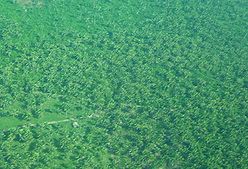Difference between revisions of "Attalea speciosa"
| Line 54: | Line 54: | ||
Special thanks to Geoff Stein, (Palmbob) for his hundreds of photos, edric. | Special thanks to Geoff Stein, (Palmbob) for his hundreds of photos, edric. | ||
| + | |||
| + | Special thanks to Dr. John Dransfield, Dr. Bill Baker & team, for their volumes of information and photos, edric. | ||
<center><gallery caption="IMAGE GALLERY" perrow="3" widths="200px" heights="200px"> | <center><gallery caption="IMAGE GALLERY" perrow="3" widths="200px" heights="200px"> | ||
Revision as of 06:31, 30 October 2012
<google>CH02</google>
| Attalea speciosa | |||||||
|---|---|---|---|---|---|---|---|
 On the final approach to Imperatriz, Maranhão, Brazil. Photo by Don Kittelson, edric. | |||||||
| Scientific Classification | |||||||
| |||||||
| Synonyms | |||||||
|
| |||||||
| Native Continent | |||||||
|
| |||||||
| Morphology | |||||||
| |||||||
| Culture | |||||||
|
| |||||||
| Survivability index | |||||||
|
| |||||||
| Common names | |||||||
|
| |||||||
Contents
Habitat and Distribution
Bolivia, Brazil North, Brazil Northeast, Brazil Southeast, Brazil West-Central, Guyana, and Suriname. You can find many babaçuais throughout the southern Amazon basin, where there is a transition between the vegetation of the rainforest to the cerrado vegetation. The clusters of this species tend to be homogeneous. It is believed that this species existed in Brazil before the arrival of settlers that served as food to the various Indian tribes, especially in the Northeast of Brazil.
Description
An imposing palm with an erect trunk, up to 20 m tall and 30-40 cm wide, apically bearing a thick crown of pinnate, erect and spreading leaves, consisting of linear-lanceolate segments. Its flowers, unisexual on monoecious plants, are clustered in slightly branched, hanging inflorescences up to 1.5 m long. Fruits are somewhat like small coconuts about 6 cm long, ovate-oblong in shape, pointed, yielded in huge amounts (up to 800-1,000 fruits per inflorescence). Editing by edric.
Culture
Would be adaptable to subtropical areas, and is frost resistant. Seeds are big and easy of to germinate, but slow. Seedlings are slow to trunk.
Comments and Curiosities
A very tough palm and can multiply despite the destruction of its habitat, for it has a capacity to regenerate quickly. In the state of Maranhão the plant generates activity for over 300 thousand families.
Uses: Its seeds yield a kind of oil commercially known as babassu oil. In order to extract it, the seeds, picked from spontaneously grown palms, are ground and squeezed by means of hydraulic presses or otherwise treated by means of chemical solvents. This oil, whose content per seed ranges between 60% and 70%, looks transparent, it smells like walnuts and turns liquid at 20-30°C, otherwise it is somewhat creamy.
As it is not greasy and possesses remarkable softening properties, babassu oil is widely employed, notably to prepare cosmetics (body and hair oils and creams, soaps, etc.); it is also employed for nutritious purposes to make margarine, as a lubricant and sometimes as a component of diesel-engine fuels.
"Women breakers" are responsible for opening the hard shell of the fruit by hand to purchase almond fruit. Local industries are major buyers using the plant oil for the manufacture of soap, glycerol and edible oil.
This plant has commercial value because its seeds produce an edible oil called babassu oil, which is also used in cleaners and skin care products. The fruit is used to produce products such as medicines, beauty aids, and beverages. Traditional communities of the Maranhão region also produce a flour from the fruit and this is commercialized as a nutritional supplement. The leaves are also used to provide thatch for houses and can be woven into mats for constructing house walls. The stems are used for timbers. The Babassu palm is considered a weed in pasture areas of Cerrado vegetation in Brazil.
Its fruits and leaves are one of the main materials used by the artisans of Tocantins (Brazil) to manufacture different art products, very popular with tourists.
In February 2008, Babassu Palm oil was used in a blend with Coconut oil and jet fuel to power one engine of a Virgin Atlantic Boeing 747 during a flight test. It is considered to be less environmentally friendly than biofuel made from the Jatropha plant that Air New Zealand tested in December 2008. This is because Babassu grows in forested areas that require deforestation, rather than in arid and land with marginal use like the Jatropha plant.
The leaves are also utilized to manufacture pieces of handicrafts like mats, baskets, hats and housewares. The incidence of this species occurs in the states of Maranhão, Piauí, Tocantins and Pará, being regarded as a native species in Maranhão.
External Links
References
All information translated from the Portuguese, edric.
Special thanks to Geoff Stein, (Palmbob) for his hundreds of photos, edric.
Special thanks to Dr. John Dransfield, Dr. Bill Baker & team, for their volumes of information and photos, edric.
- IMAGE GALLERY
- Babaçu.jpg
Near the road to Pinheiro, Maranhão, Brazil.
- Babaçu2.jpg
Brazil. Photo-infoescola.com, edric.
- Babaçu00.jpg
Brazil. Photo-infoescola.com, edric.
Many Special Thanks to Ed Vaile for his long hours of tireless editing and numerous contributions.




























